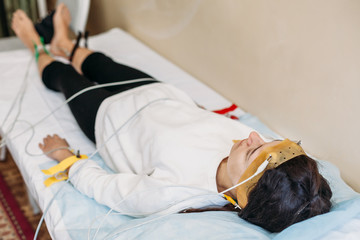Just How a Sleep Research Can Transform Your Rest Patterns: Insights and Providers Available
A sleep research study works as a vital tool for people looking for to comprehend and enhance their sleep patterns. It uses a thorough evaluation of rest behaviors and possible problems. By assessing various metrics, health care experts can determine underlying problems that interfere with restorative remainder. This process not only aids in diagnosis yet additionally establishes the stage for tailored treatment plans. What insights might a rest research disclose regarding your own sleep routines?
Understanding Rest Studies: What to Expect
When individuals get ready for a rest research study, they usually question what the experience will certainly involve. These studies, commonly carried out in a rest facility, objective to keep an eye on different physiological criteria during rest. Upon arrival, participants are greeted by skilled service technicians who assist them with the procedure. The setting is made to be comfy, enabling a natural sleep experience. Individuals might be asked to fill out surveys concerning their sleep routines and clinical history, which aids in the assessment.
As the evening proceeds, sensors are affixed to the body to track mind waves, heart rate, and breathing patterns. While the configuration might feel unusual, the objective is to gather precise data on the person's sleep patterns. The whole treatment is non-invasive and poses no danger to the participant. Inevitably, the data collected throughout the rest research study is crucial for detecting possible sleep problems and developing efficient therapy plans.
Usual Sleep Disorders Determined Via Sleep Researches
Rest research studies play a vital duty in identifying numerous sleep problems that can significantly impact an individual's health and wellness. Usual problems found through these studies include obstructive rest apnea, defined by duplicated disturbances in breathing throughout rest, causing fragmented sleep patterns. An additional common condition is sleeplessness, which involves trouble falling or remaining asleep, commonly leading to daytime fatigue and damaged functioning. Restless legs syndrome (RLS) is likewise often observed, creating uneasy experiences in the legs and an uncontrollable desire to move them at evening. Narcolepsy, a neurological problem that affects sleep-wake cycles, is one more severe condition recognized in sleep research studies, resulting in too much daytime sleepiness and sudden sleep strikes. Parasomnias, which incorporate abnormal behaviors during rest, such as sleepwalking or evening horrors, are also noted. Early identification of these conditions can promote timely intervention and improve overall rest high quality.
The Refine of a Rest Research Study: From Preparation to Results
The procedure of a rest study may seem intimidating, it is a structured and systematic approach developed to collect important details about an individual's sleep patterns. Originally, a doctor conducts a thorough examination, discussing sleep history and signs and symptoms with the client. This analysis helps establish the certain focus of the research.
Preparation generally entails guidelines on sleep hygiene and medicine modifications prior to the research. Patients may be advised to avoid high levels of caffeine and alcohol to guarantee exact outcomes. On the evening of the research, electrodes and sensing units are placed to check mind activity, heart price, breathing, and activities throughout rest.
The data collected is carefully analyzed by rest experts, that determine any type of irregularities or patterns a measure of rest conditions. Following this analysis, a follow-up consultation is set up to discuss the searchings for and prospective therapy choices tailored to the patient's requirements, facilitating improved sleep high quality.

Sorts Of Rest Studies: In-Lab vs. Home Sleep Tests
Two key kinds of rest studies exist: in-lab studies and home sleep tests, each accommodating different needs and situations. In-lab research studies usually happen in a rest center where people are kept an eye on overnight by medical care professionals. This method permits detailed information collection on numerous sleep criteria, such as brain task, oxygen levels, and heart rate. Patients are frequently attached to multiple sensing units, offering in-depth understandings into their sleep disorders, consisting of sleep apnea and narcolepsy.
On the other hand, home rest examinations use a much more convenient alternative for individuals that prefer to carry out evaluations in their own atmosphere. These mobile tools check essential metrics like airflow, oxygen saturation, and snoring. While home tests are less extensive than in-lab studies, they serve as a sensible solution for identifying common rest disorders. Eventually, the selection in between these 2 types of sleep studies relies on individual choices, clinical needs, and the intensity of sleep-related issues.
Translating Your Sleep Research Results: Trick Metrics Clarified
Comprehending the outcomes of a rest study is important for people seeking understandings into their rest health. Secret metrics typically assessed in rest studies include the Apnea-Hypopnea Index (AHI), which gauges the number of apneas and hypopneas per hour of sleep. AHI worths aid identify the seriousness of rest apnea, with greater scores indicating much more significant concerns. One more important metric is the total sleep time (TST), which shows the general period of sleep throughout the research study. Rest effectiveness, the proportion of time spent asleep to time spent in bed, is likewise essential; higher portions show much better sleep top quality. In addition, the percent of sleep invested in various phases-- light, deep, and rapid eye movement-- provides understandings into sleep style. Comprehending these metrics gears up patients with the expertise required to review their sleep patterns with medical care service providers, leading the method for educated choices find this regarding their rest health and wellness.
Treatment Choices and Recommendations Based Upon Your Sleep Research study
When a sleep study reveals issues such as rest apnea or other rest conditions, numerous treatment options and recommendations appear to improve total rest health. For obstructive sleep apnea, constant favorable airway pressure (CPAP) therapy is typically prescribed, supplying a stable stream of air to maintain air passages open throughout sleep. Oral devices may be advised for moderate to modest cases, repositioning the jaw to protect against airway obstruction.
In cases of sleeping disorders, cognitive behavior therapy for sleeplessness (CBT-I) is usually recommended, focusing on behavioral modifications and assumed patterns that interrupt sleep. Furthermore, lifestyle adjustments such as fat burning, regular workout, and staying clear of alcohol or caffeine before bedtime might enhance rest quality.

Building Healthy And Balanced Sleep Behaviors: Tips for Better Relax
Structure healthy sleep habits is crucial for attaining restorative remainder. Establishing a regular sleep routine, visit our website restricting screen time before bed, and creating a comfy sleep setting can greatly enhance rest high quality. These approaches work as fundamental steps for people seeking far better rest end results.
Develop a Rest Regimen
Developing a regular sleep regimen is vital for promoting healthy and balanced sleep habits and boosting overall well-being. Sleep Study Bangalore. A normal sleep routine, where individuals go to bed and get up at the very same time each day, strengthens the body's natural body clocks. This predictability assists control the sleep-wake cycle, bring about boosted rest high quality. Creating a soothing pre-sleep routine, such as reading or practicing leisure strategies, can signify the body that it is time to unwind. In addition, maximizing the rest environment-- by maintaining a comfortable temperature, decreasing noise, and guaranteeing darkness-- can additionally support peaceful sleep. By prioritizing these techniques, people can cultivate a sustainable sleep regimen that cultivates restorative sleep and adds to better psychological and physical health and wellness
Restriction Display Time
As people progressively depend on displays for enjoyment and communication, restricting screen time prior to bed has actually come to be necessary for promoting far better rest. Research study shows that direct exposure to blue light emitted by tools such as tablet computers, mobile phones, and computers can disrupt the production of melatonin, the hormonal agent in charge of regulating rest. Experts advise transforming off displays at the very least one hour before going to bed to improve rest high quality. Engaging in alternate tasks, such as practicing or reviewing a publication relaxation techniques, can assist individuals unwind and prepare for sleep. By purposely minimizing display time, people can cultivate healthier rest patterns, bring about boosted general wellness and increased daytime performance. Prioritizing this aspect of rest health is critical for long-lasting health.
Develop a Rest Refuge
Creating a rest shelter can considerably enhance an individual's capacity to achieve relaxing sleep. This atmosphere must focus on convenience and peace, incorporating aspects that advertise relaxation. A suitable cushion and pillows are crucial, as they straight impact sleep high quality. Furthermore, the area should be dark, quiet, and cool; using blackout drapes and white sound makers can facilitate this atmosphere. Customizing the area with soothing shades and aromas, such as lavender, can additionally enhance leisure. Minimizing clutter also adds to a tranquil atmosphere, enabling psychological clearness - Sleep Study Bangalore. By attentively designing a rest sanctuary, individuals can foster healthier sleep behaviors and produce a consistent routine, inevitably resulting in enhanced overall wellness and restorative remainder
Frequently Asked Concerns
Just how Lengthy Does It Require To See Improvements After a Sleep Research study?
Improvements after a rest study can differ, however lots of people start to discover positive changes within a few weeks. Regular follow-up and adherence to advised treatments play essential functions in attaining perfect results.

Can Children Undergo Sleep Researches, and Just How Are They Various?
Yes, youngsters can go through sleep studies, which differ from grown-up researches in keeping track of techniques and tools. Pediatric examinations frequently involve child-friendly environments and might consist of parent engagement to assure convenience and exact outcomes.
Are Sleep Research Studies Covered by Insurance Coverage, and What Are the Prices?
Sleep studies can be covered by insurance policy, depending upon the plan and medical necessity. Costs differ widely, varying from $300 to $3,000, influenced by the type of research and location of the center.
What Lifestyle Changes Can Boost the Efficiency of Rest Research Results?

Executing regular sleep timetables, minimizing high levels of caffeine consumption, developing a calming going to bed routine, and maintaining a comfortable sleep setting can considerably boost the performance of rest research results, promoting better rest high quality and total health.
Exactly how Often Should I Repeat a Sleep Study for Ongoing Issues?
Individuals experiencing continuous rest problems ought to take into consideration repeating a sleep research study each to 2 years, or as recommended by medical care professionals, to keep track of changes have a peek at this site and adjust treatment strategies successfully based upon their progressing sleep patterns. (Sleep Study Bangalore)
Rest researches play a necessary function in identifying numerous sleep conditions that can greatly impact an individual's wellness and health. Usual disorders identified through these studies consist of obstructive sleep apnea, identified by duplicated disturbances in breathing throughout sleep, leading to fragmented rest patterns. When a sleep study exposes concerns such as rest apnea or various other rest conditions, various therapy alternatives and referrals become available to enhance overall rest health. Establishing a consistent rest regimen, limiting screen time before bed, and developing a comfortable rest atmosphere can significantly improve sleep high quality. Additionally, enhancing the rest setting-- by maintaining a comfy temperature, decreasing sound, and ensuring darkness-- can even more support restful rest.